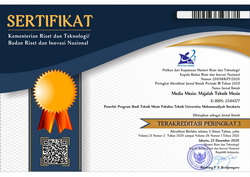CHARACTERIZATION OF BAMBOO TUTUL CHARCOAL PARTICLE PRODUCED BY HIGH ENERGY BALL MILLING SHAKER TYPE
S Supriyono(1*), B Susilo(2)(1) Universitas Muhammadiyah Surakarta
(2) Universitas Muhammadiyah Surakarta
(*) Corresponding Author
Abstract
Keywords
Full Text:
PDFReferences
L. Zou, H. Jin, W.-Y. Lu, and X. Li, “Nanoscale structural and mechanical
characterization of the cell wall of bamboo fibers,” Mater. Sci. Eng. C, vol. 29, no. 4, pp.
–1379, 2009.
D. B. Effendi, N. H. Rosyid, A. Bayu, and D. Nandiyanto, “Review : Sintesis
Nanoselulosa,” J. Untirta, vol. 5, no. 2, pp. 61–74, 2015.
A. Kumar et al., “Engineered bamboo scrimber: Influence of density on the mechanical
and water absorption properties,” Constr. Build. Mater., vol. 127, pp. 815–827, 2016.
J. Q. Krause, F. de Andrade Silva, K. Ghavami, O. da F. M. Gomes, and R. D. T.
Filho, “On the influence of Dendrocalamus giganteus bamboo microstructure on its
mechanical behavior,” Constr. Build. Mater., vol. 127, pp. 199–209, 2016.
S. Zhao, C. Y. Wang, M. M. Chen, Z. Q. Shi, and N. Liu, “Preparation of carbon spheres
from potato starch and its stabilization mechanism,” Xinxing Tan Cailiao/New Carbon
Mater., vol. 25, no. 6, pp. 438–443, 2010.
A. N. Mohan and B. Manoj, “Synthesis and characterization of carbon nanospheres
from hydrocarbon soot,” Int. J. Electrochem. Sci., vol. 7, no. 10, pp. 9537–9549, 2012.
J. Rao, G. Catherin, in Murthy, D. Rao, and B. Raju, “Production of nano structured
silicon carbide by high energy ball milling,” Int. J. Eng. Sci. Technol., vol. 3, no. 4, pp.
–88, 2011.
Supriyono, Ngafwan, W Joharwan, “The effect of the ball size on the product
characteristics of shaker HEM
to produce nano particle from bamboo charcoal”, IOP Conf. Ser.: Mater. Sci. Eng. 403
, 2018.
F. G. Salihati and H. Ardhyananta, “Studi Pembuatan Karbon Hitam dari Bambu Ori
(Bambusa arundinacea) dan Bambu Petung (Dendrocalamus asper),” Tek. Pomits, vol.
, no. 2, pp. 1–6, 2013.
J. Zhang, Y. Bai, H. Dong, Q. Wu, and X. Ye, “Influence of ball size distribution on
grinding effect in horizontal planetary ball mill,” Adv. Powder Technol., vol. 25, no. 3,
pp. 983–990, 2014.
S. Giat and W. Ari, “Pembentukan Nanopartikel Paduan CoCrMo Dengan Metoda
Pemanduan Mekanik,” Pus. Teknol. Bahan Ind. Nukl. – BATAN, 2012.
P. Kuziora, M. Wyszyńska, M. Polanski, and J. Bystrzycki, “Why the ball to powder
ratio (BPR) is insufficient for describing the mechanical ball milling process,” Int. J.
Hydrogen Energy, vol. 39, no. 18, pp. 9883–9887, 2014.
Y. Do Kim, J. Y. Chung, J. Kim, and H. Jeon, “Formation of nanocrystalline Fe-Co
powders produced by mechanical alloying,” Mater. Sci. Eng. A, vol. 291, no. 1, pp.
–21, 2000.
J. Eckert and I. Börner, “Nanostructure formation and properties of ball-milled NiAl
intermetallic compound,” Mater. Sci. Eng. A, vol. 239–240, pp. 619–624, 1997.
Article Metrics
Abstract view(s): 284 time(s)PDF: 323 time(s)
Refbacks
- There are currently no refbacks.








